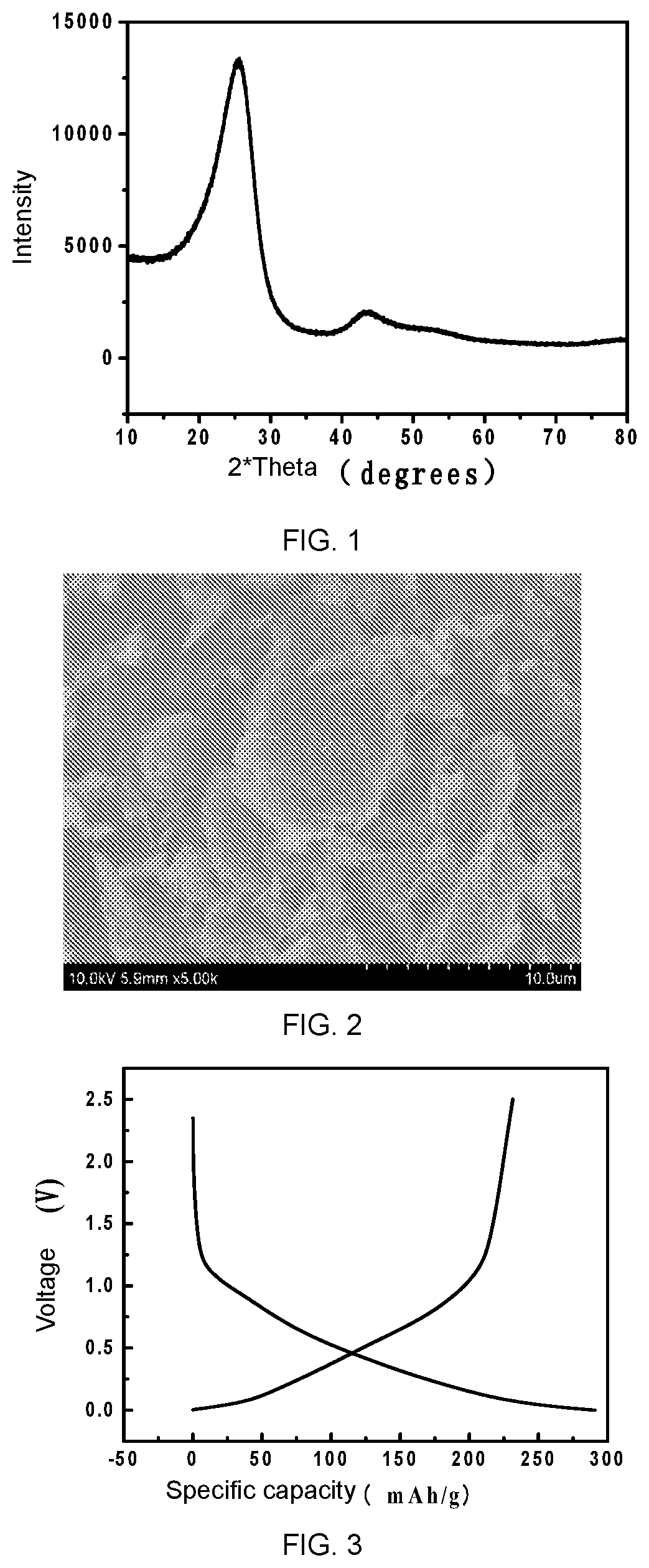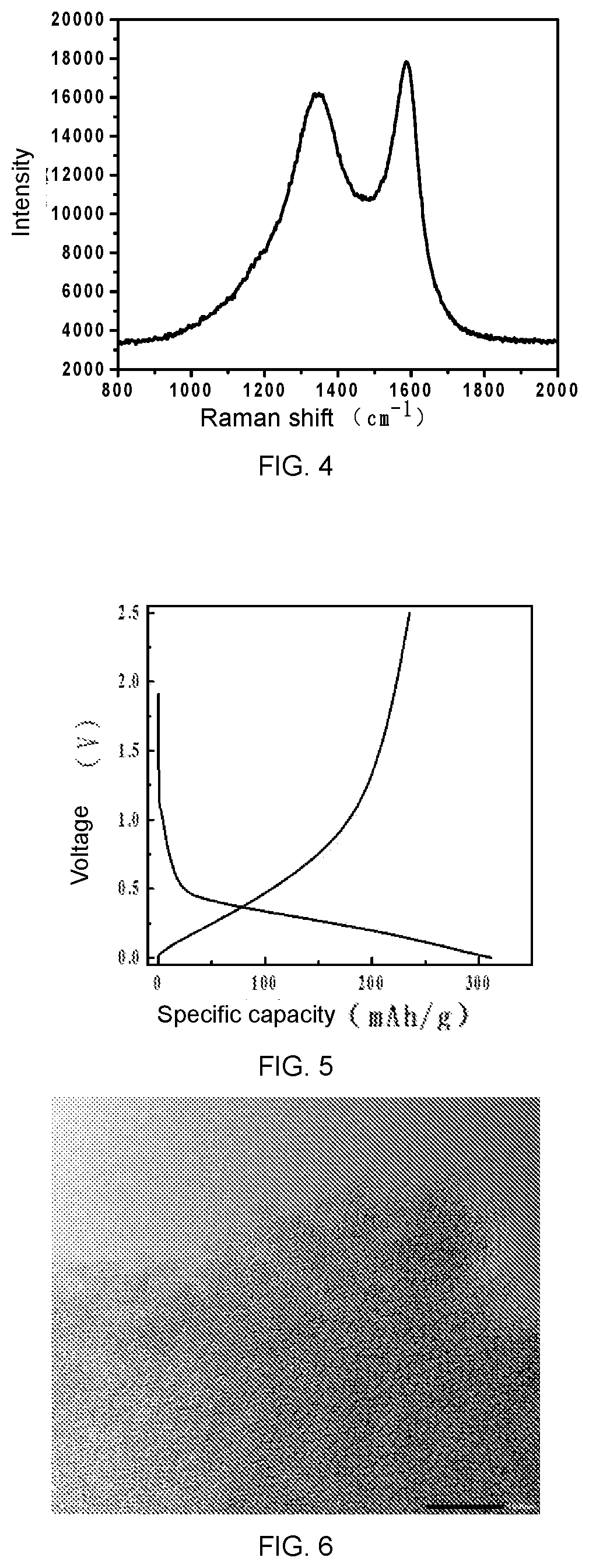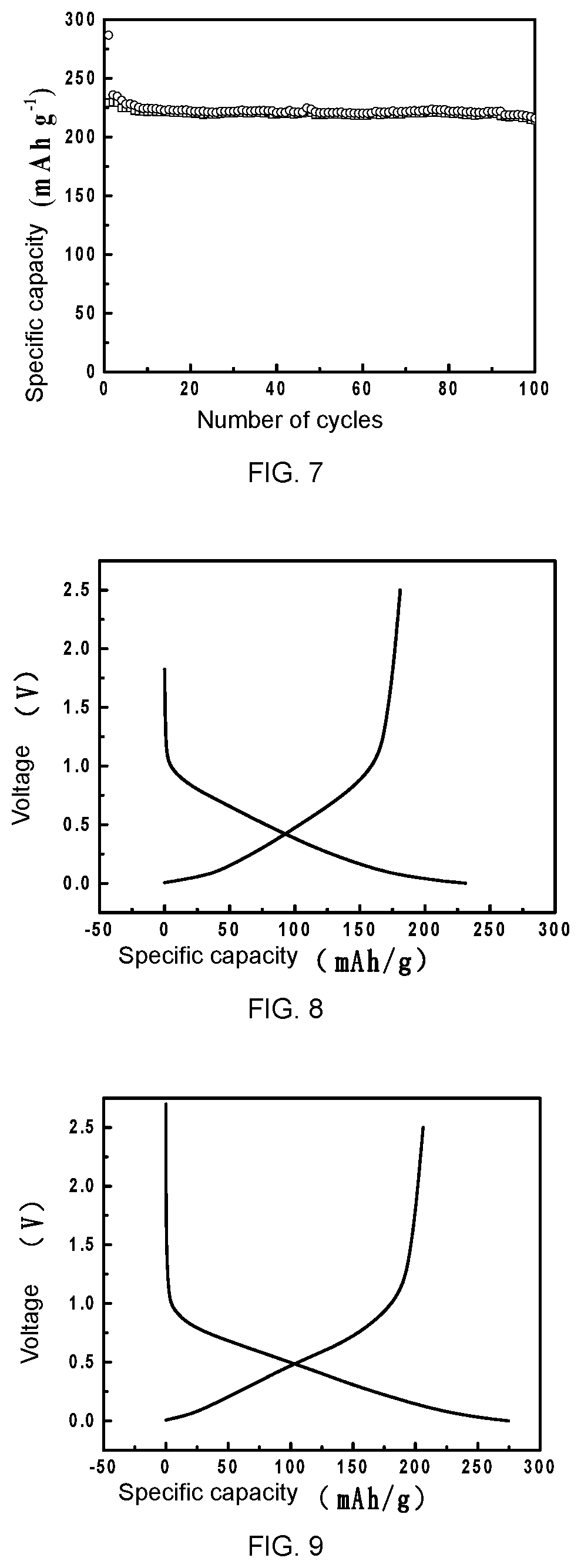Carbon-based anode material with high slopecapacity and preparation method therefor and use thereof
a technology of anode material and slope capacity, which is applied in the field of materials, can solve the problems of increasing the cost of lithium resources, affecting the sustainability of mankind, and the output of these energy sources is difficult to maintain, and achieves the effects of low carbonization temperature, high slope capacity, and simple and easy preparation process
- Summary
- Abstract
- Description
- Claims
- Application Information
AI Technical Summary
Benefits of technology
Problems solved by technology
Method used
Image
Examples
embodiment 1
[0063]1 g of pitch is placed into a 20 mL graphite crucible, and the graphite crucible is then placed into a tube furnace where the pitch is carbonized at 950° C. for 2 hours under an Ar atmosphere, thus obtaining the final carbon-based anode material. The X-ray diffraction (XRD) pattern and scanning electron microscope (SEM) image of the carbon-based anode material are shown in FIG. 1 to FIG. 2. The X-ray diffraction (XRD) pattern has no obvious diffraction peak, indicating that the obtained carbon-based anode material is an amorphous carbon-based anode material. The obtained carbon-based anode material is made into a pole piece, which is assembled into a button cell with sodium metal as a counter electrode and 1 mol / L NaPF6 EC / DMC (1:1) as electrolyte. Its charge-discharge curve is measured at 0.1C. As shown in FIG. 3, the test results show that the electrochemical curve basically only includes a slope section (see FIG. 21 of Comparative Embodiment 2. In Comparative Embodiment 2, ...
embodiment 2
[0064]1 g of anthracite is placed in a 20 mL graphite crucible, and the crucible is then placed in a muffle furnace to keep the anthracite at 350° C. for 12 hours. The material taken out is treated at 650° C. for 24 hours under an Ar atmosphere, thus obtaining the final carbon-based anode material. The Raman spectrum of the carbon-based anode material is shown in FIG. 4, and the ID / IG value calculated by the Raman spectrum is 2.57, which shows that the prepared carbon-based anode material has a high degree of disorder and small graphitized flakes. The obtained carbon-based anode material is made into a pole piece, which is assembled into a button cell with sodium metal as a counter electrode and 1 mol / L NaPF6 EC / DMC (1:1) as electrolyte. Its charge-discharge curve is measured at 0.1C. The first-cycle charge capacity is as high as 219.1 mAh / g, almost all of which comes from the slope section, and the initial Coulombic efficiency is as high as 79%.
embodiment 3
[0065]2 g of corn stalks are crushed, dispersed in 50 mL of water, and placed in a 100 mL beaker, and the beaker is then placed in an oven where the resulting material is heated to 180° C. and kept at 180° C. for 24 hours. Then the washed and dried powder is put in a tube furnace and treated at 700° C. for 10 hours in a N2 atmosphere, thus obtaining the final carbon-based anode material. The obtained carbon-based anode material is made into a pole piece, which is assembled into a button cell with sodium metal as a counter electrode and 1 mol / L NaPF6 EC / DMC (1:1) as electrolyte. Its charge-discharge curve is measured at 0.1C. As shown in FIG. 5, the test results show that the capacity is as high as 230.5 mAh / g, almost all of which comes from the slope section, and the initial Coulombic efficiency is as high as 75.9%.
PUM
| Property | Measurement | Unit |
|---|---|---|
| Coulombic efficiency | aaaaa | aaaaa |
| specific surface area | aaaaa | aaaaa |
| temperature | aaaaa | aaaaa |
Abstract
Description
Claims
Application Information
 Login to View More
Login to View More - R&D
- Intellectual Property
- Life Sciences
- Materials
- Tech Scout
- Unparalleled Data Quality
- Higher Quality Content
- 60% Fewer Hallucinations
Browse by: Latest US Patents, China's latest patents, Technical Efficacy Thesaurus, Application Domain, Technology Topic, Popular Technical Reports.
© 2025 PatSnap. All rights reserved.Legal|Privacy policy|Modern Slavery Act Transparency Statement|Sitemap|About US| Contact US: help@patsnap.com



